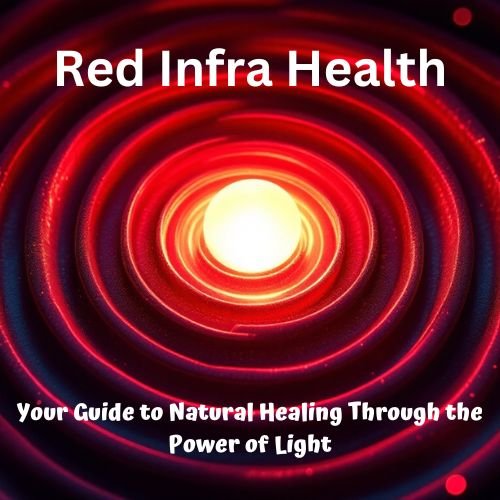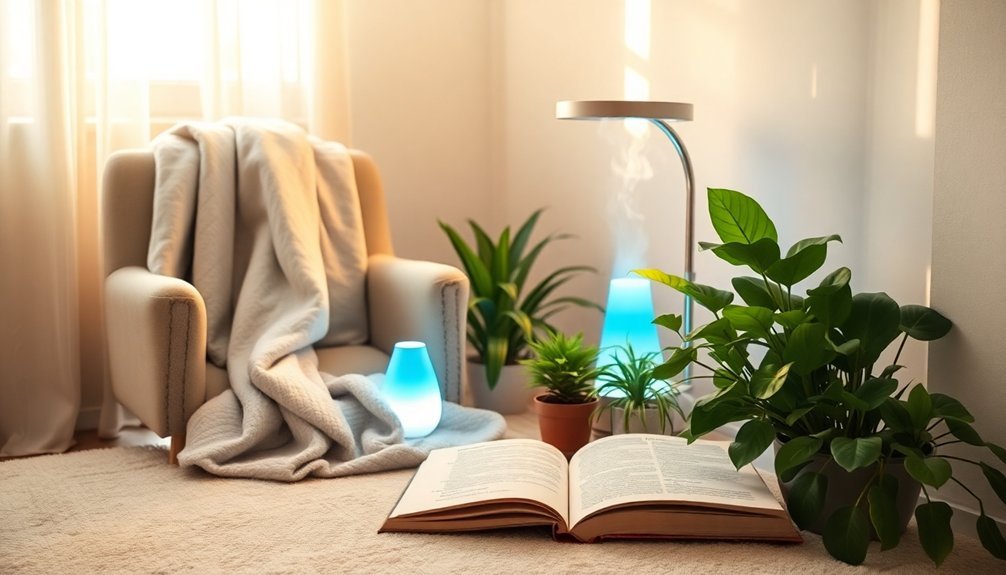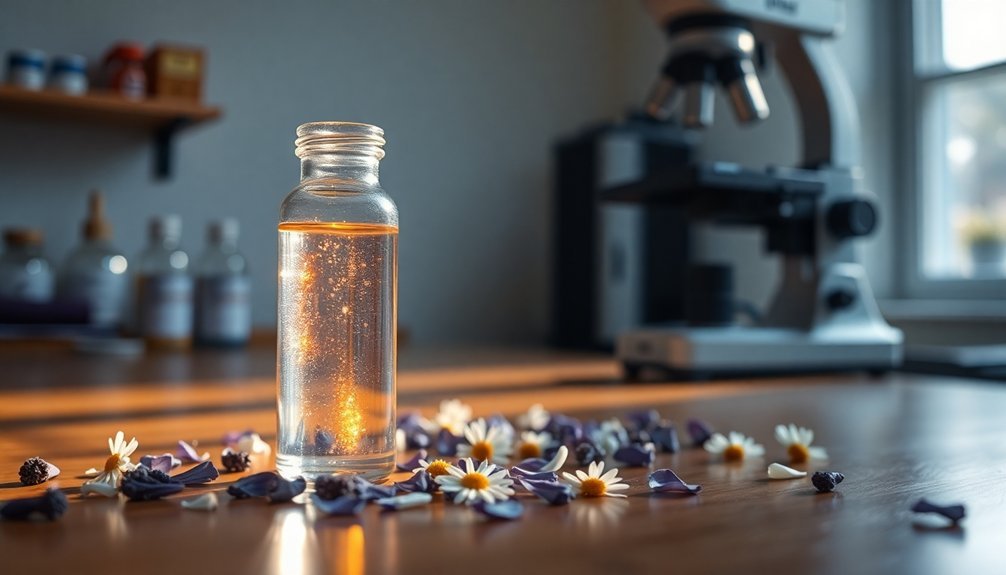LED light therapy transforms your osteoarthritis pain management by working at the cellular level to stimulate natural healing processes. When specific wavelengths of red and near-infrared light penetrate your joints, they boost ATP production and trigger photochemical reactions that reduce inflammation and pain. You'll experience improved mobility as the therapy enhances blood flow through nitric oxide release, delivering essential nutrients to damaged tissues. Clinical studies show up to 50% pain reduction, with benefits lasting 4-6 months after treatment. This non-invasive approach offers a powerful solution that goes beyond traditional pain management, and there's much more to discover about its healing potential.
Understanding LED Light Therapy Basics

In light of recent medical advances, LED light therapy has emerged as a promising treatment option for osteoarthritis pain management. This non-invasive treatment uses specific wavelengths of light, particularly red and infrared, to penetrate deep into your joints and tissues where osteoarthritis causes the most damage.
When you undergo LED light therapy, the light energy triggers photochemical reactions in your cells, stimulating their natural healing processes. Your cells respond by increasing ATP production, which boosts cellular energy and promotes tissue repair. As a preventive measure, eye protection is essential during these treatments.
The therapy also enhances blood flow by releasing nitric oxide, which widens your blood vessels and helps circulate anti-inflammatory proteins throughout the affected areas.
You'll find LED therapy devices in various formats, including masks, wands, panels, and flexible pads. Each type serves specific purposes, with red and infrared lights being most effective for osteoarthritis pain relief. These wavelengths penetrate deeper than other colors, directly targeting your muscles and joints.
The treatment's safety profile is impressive – you won't experience significant side effects, and there's no recovery time needed. Plus, you can combine LED therapy with other treatments, making it a versatile addition to your pain management strategy.
Science Behind Pain Relief
Your cells respond to LED therapy's specific wavelengths by increasing ATP production and triggering a cascade of healing processes that repair damaged tissue.
Clinical evidence shows over 4,000 studies have validated LED therapy's effectiveness for musculoskeletal conditions.
Red and near-infrared light penetrates deep into your joints, where it disrupts pain signals and reduces inflammation through the modulation of nitric oxide pathways.
The light energy works directly at the cellular level, stimulating blood flow and activating your body's natural pain-relief mechanisms while promoting long-term healing.
Cellular Healing Process Explained
Light therapy's impact on cellular healing follows a fascinating cascade of biological events that directly target pain and inflammation in osteoarthritic joints. When you undergo LED therapy, your cells experience increased ATP production, boosting their energy levels and kickstarting natural healing processes.
The therapy's effects on your cellular health occur through multiple pathways:
| Cellular Process | Direct Benefit |
|---|---|
| ATP Production | Enhanced cellular energy for repair |
| Oxidative Stress | Reduced damage to articular cartilage |
| Chondrocyte Activity | Increased cartilage cell growth |
| Inflammatory Response | Decreased harmful inflammation |
| Tissue Repair | Improved joint structure and function |
Your body's healing response intensifies as the light therapy promotes chondrocyte proliferation while preventing cell death. You'll notice improvements in cartilage structure as the treatment increases protective factors like IL-4 and IL-10. The therapy also maintains tissue balance by modulating your antioxidant enzyme activity, which helps preserve joint health. Studies show patients often achieve sustained benefits even 30 days after completing their treatment protocol. This cellular restoration process doesn't just mask pain—it actively works to improve your joint's structural integrity and function, making it a powerful tool for managing osteoarthritis symptoms.
Light Wavelength Impact Mechanics
Understanding how specific wavelengths target osteoarthritis pain reveals the precision behind LED therapy's effectiveness. Your joints receive targeted healing through specific light wavelengths, with red light (620-750 nm) and near-infrared light (785-905 nm) penetrating deep into affected tissues where conventional treatments can't reach.
You'll find the most powerful pain relief comes from the 904-905 nm wavelength range, which ranks as the most effective for knee osteoarthritis. When these wavelengths reach your joint tissues, they trigger a cellular response that directly impacts your pain and inflammation at the source. This process creates biochemical changes in cells that promote natural tissue regeneration.
Your cells' mitochondria interact with the light, boosting energy production and accelerating the healing process.
The World Association for Laser Therapy recommends specific dosages for the best results: you'll need ≥4 J/point when using 780-860 nm wavelengths, or ≥1 J/point with 904 nm wavelengths for knee treatment. These precisely calibrated doses guarantee you're getting the most effective treatment possible.
The light's interaction with your tissues reduces oxidative stress and inflammatory cytokines, while simultaneously promoting beneficial effects like increased blood flow and reduced synovitis in your affected joints.
Pain Signal Disruption Pathway
While osteoarthritis pain involves complex pathways, LED therapy disrupts pain signals through multiple mechanisms in your body's nervous system. When you experience joint pain, inflammatory mediators activate nociceptors, triggering a cascade of pain signals that travel to your brain. LED therapy intercepts these signals at multiple points, providing quick relief. Clinical evidence shows that synovitis and inflammation are major contributors to ongoing joint pain.
| Pain Mechanism | LED Effect | Benefit |
|---|---|---|
| Peripheral Sensitization | Reduces NGF/TrkA signaling | Decreases nerve sensitivity |
| Inflammatory Response | Inhibits TNF-α and IL-1β | Lowers inflammation |
| Central Processing | Modulates neurotransmitters | Enhances pain control |
| Neural Conduction | Blocks pain transmission | Immediate relief |
Your pain relief occurs through two primary mechanisms. First, LED therapy reduces peripheral sensitization by dampening the activity of pain receptors in your joints. Second, it influences central pain processing by modulating neurotransmitters like serotonin and endorphins. This dual action explains why you'll often feel immediate pain relief during treatment, while also experiencing longer-term benefits through reduced inflammation and enhanced tissue repair.
Clinical Research Proven Results

Research-backed evidence demonstrates LED therapy's remarkable effectiveness in managing osteoarthritis pain. Clinical trials consistently show significant pain reduction, with studies reporting up to 50% decrease in knee osteoarthritis discomfort.
A notable study involving 50 patients with degenerative osteoarthritis revealed substantial improvements in both pain levels and mobility after low-power light therapy treatments. The research showed patients receiving treatment needed retreatment only after 4-6 months.
You'll find compelling evidence in these key research findings:
- Double-blind trials confirm LED therapy's ability to reduce acute joint inflammation and chronic pain through photobiomodulation
- Meta-analyses validate low-level laser therapy's effectiveness specifically for osteoarthritis treatment
- Studies demonstrate decreased TNF-α expression in treated joints, confirming the therapy's anti-inflammatory properties
Your treatment outcomes are supported by extensive scientific research, including ongoing studies like the IPPaM trial. The therapy's success isn't just about immediate pain relief – you're looking at potentially long-term benefits that can last several months.
Clinical data shows LED therapy effectively stimulates your body's natural painkillers while promoting tissue repair and enhanced joint function, offering you a non-invasive solution backed by solid scientific evidence.
LED Treatment Protocol
A successful LED therapy journey begins with following a precise treatment protocol. You'll need to commit to 10-15 minute sessions twice daily for 10 days, or alternatively, attend twice-weekly sessions for 10-16 treatments total.
The therapy targets both sides of your knee, focusing particularly around the patella to guarantee maximum penetration of the articular cartilage. Over 350 million people worldwide rely on various treatments for joint pain and inflammation.
Your healthcare provider will determine the appropriate energy dosage, typically ranging from 4-8 J per point using 785-860 nm wavelengths, or 1-3 J with 904 nm wavelength per treatment spot.
The most studied wavelengths include 633 nm, 830 nm, 810 nm, 890 nm, and 904 nm, with energy densities of 2.4 J/cm² or 10 mW/cm² for one hour, depending on your device.
While LED therapy is generally safe with minimal side effects, you'll want to consult your healthcare provider before starting treatment, especially if you have conditions like epilepsy.
The effectiveness of your treatment can vary based on the device quality, so it's crucial to use professional-grade equipment and follow the prescribed protocol precisely for the best results.
Different Light Wavelengths Matter

Understanding the distinct wavelengths in LED therapy holds the key to effective osteoarthritis treatment. When you're dealing with joint pain, you'll find that different light wavelengths penetrate your tissues at varying depths, each offering unique therapeutic benefits for managing your condition.
- Red light wavelengths work effectively at reducing pain and inflammation while boosting circulation through nitric oxide release, leading to better oxygen delivery to your affected joints. Regular treatments can provide fast pain relief within minutes of application.
- Infrared light reaches deeper into your tissues than red light, directly targeting the source of inflammation and promoting enhanced cellular repair through increased ATP production.
- The combination of red and infrared wavelengths provides thorough treatment, as they work synergistically to improve joint mobility, reduce stiffness, and stimulate long-lasting tissue regeneration.
You'll appreciate that these specific wavelengths aren't just randomly chosen – they're backed by clinical evidence showing their effectiveness in treating osteoarthritis symptoms.
When you select an LED device, it's vital to make certain it delivers the appropriate wavelengths for maximum therapeutic benefit.
The beauty of this treatment lies in its non-invasive nature and impressive safety profile, making it an excellent choice for long-term pain management.
Natural Healing Through Light
Through the power of red and infrared light therapy, your body activates its natural healing mechanisms to combat osteoarthritis pain. When photons penetrate deep into your muscle and joint tissue, they trigger a cascade of cellular responses that boost your body's natural repair processes.
Your mitochondria absorb these light wavelengths, leading to increased ATP production and enhanced cellular function.
You'll experience multiple healing benefits as the light therapy stimulates nitric oxide release, causing your blood vessels to dilate. This increased blood flow delivers more oxygen and nutrients to affected areas, while simultaneously activating pain-relieving pathways.
The therapy also promotes collagen production, which can help regenerate cartilage and slow joint degradation.
What makes this treatment particularly appealing is its non-invasive nature and absence of side effects. You can manage your symptoms with just 20 minutes of daily treatment in the comfort of your home.
Clinical studies consistently show that red light therapy provides significant pain reduction and improved joint function. It's an FDA-cleared treatment that's proven to deliver long-lasting relief, making it an effective solution for managing your osteoarthritis symptoms over time.
Comparing Traditional Pain Treatments

Many conventional treatments for osteoarthritis pain offer varying degrees of relief, each with distinct advantages and limitations. When you're dealing with joint pain, you'll typically encounter options ranging from oral medications to physical therapies and injections.
- NSAIDs remain a common first-line treatment, available both over-the-counter and by prescription, but they carry risks of stomach, heart, and liver complications. You'll find topical versions offer similar relief with fewer side effects.
- Physical and occupational therapies provide natural strengthening solutions through exercises and lifestyle modifications. You're able to combine these with other treatments while learning valuable techniques for protecting your joints during daily activities.
- Injectable treatments like corticosteroids deliver quick relief, while hyaluronic acid offers potential long-term benefits by mimicking your natural joint fluid.
While these traditional approaches can be effective, they don't address the cellular healing process like LED light therapy does.
Where medications mask pain and inflammation, red and near-infrared light therapy works at the cellular level to promote natural healing and reduce inflammation, offering a promising alternative or complement to conventional treatments.
Home Treatment Success Stories
Real patients' success stories with LED therapy paint a compelling picture of its effectiveness in managing osteoarthritis at home. Users consistently report substantial pain relief and improved mobility after incorporating LED therapy into their daily routines. For instance, Kelly Stone's father experienced notable improvements in his arthritis symptoms through regular home treatments.
You'll find that LED therapy's convenience makes it easier to stick with your treatment plan. The portable devices let you manage your condition while watching TV, working at your desk, or relaxing in bed.
More importantly, you'll likely notice immediate benefits – many users report instant pain relief following their sessions.
What makes these success stories particularly meaningful is how LED therapy helps people return to their daily activities. You'll be able to perform regular tasks with less pain and stiffness, markedly improving your quality of life.
The treatment's ability to reduce joint pain by more than 50% isn't just a statistic – it represents real people getting back to their normal lives. Regular use leads to sustained improvements in joint health, making LED therapy a practical long-term solution for managing osteoarthritis symptoms at home.
Long Term Benefits

You'll notice significant and lasting pain relief from LED therapy that can persist for months or even years after consistent treatment sessions.
Your joints will experience a gradual restoration process as the therapy accelerates tissue repair, reduces inflammation, and promotes cartilage healing at the cellular level.
The improvements in your daily activities become more permanent as you continue treatment, with enhanced mobility, reduced stiffness, and better joint function allowing you to maintain an active lifestyle.
Sustained Pain Relief Benefits
Scientific evidence points to remarkable long-term benefits of LED therapy for individuals living with osteoarthritis pain. When you undergo LED therapy, red and near-infrared light penetrates deep into your affected joints, triggering a cascade of biological responses that lead to sustained pain relief.
Your cells receive an energy boost through photobiomodulation, which enhances tissue repair and reduces inflammation at the cellular level.
What makes LED therapy particularly effective for long-term pain management:
- It modulates your neurotransmitters, including serotonin and endorphins, creating natural pain relief that lasts longer than traditional treatments.
- You'll experience a down-regulation of second-order neurons in persistent pain conditions, which means your pain signals become less intense over time.
- Your peripheral nerve sensitization decreases, making you less susceptible to pain triggers.
The therapy's ability to preserve your joint's articular surface while decreasing inflammation means you'll benefit from both immediate and lasting relief. You won't just mask the pain – you'll be addressing the underlying causes through increased circulation and cellular repair.
This non-invasive approach offers you a safe, drug-free solution that's particularly effective for managing chronic osteoarthritis symptoms.
Joint Health Restoration Process
Beyond immediate pain relief, LED therapy initiates a thorough joint restoration process that transforms your overall joint health. The therapy's powerful anti-inflammatory effects target your joints directly, modulating cellular processes and immune responses to reduce inflammation and promote faster healing.
You'll benefit from enhanced cellular healing as LED therapy increases ATP production and restores cellular respiration in damaged cells. Your mitochondrial activity improves, leading to better cell proliferation and tissue regeneration.
The therapy also works to preserve your articular cartilage's integrity while stimulating angiogenesis in the synovium.
The restoration process extends to significant tissue repair, where LED therapy stimulates biological processes that support regeneration. You'll experience improved tissue survival as the therapy reduces caspase-3 expression and modulates antioxidant enzymatic activity. Histological markers consistently show positive changes in tissue healing with continued treatment.
What's particularly valuable is the sustained nature of these restorative effects. You'll notice long-term improvements in joint function and reduced inflammation, with extended periods between required treatments. Regular maintenance sessions help you maintain these benefits, ensuring lasting improvements in your joint health.
Daily Function Improvements Persist
Three key long-term benefits emerge when patients commit to LED therapy for osteoarthritis management. These persistent improvements can transform your daily life and provide lasting relief from chronic joint pain:
- You'll experience extended periods of pain relief compared to traditional treatments, with clinical trials showing that regular LED therapy sessions lead to sustained improvement in pain management.
- Your joint mobility will substantially improve over time, making everyday activities easier and reducing your reliance on pain medications.
- You'll notice a measurable decrease in disability levels, allowing you to regain independence and participate more fully in daily activities.
What's particularly encouraging is that these improvements aren't temporary fixes. When you follow recommended treatment protocols, the benefits build up gradually and persist longer.
The non-invasive nature of LED therapy means you can maintain your treatment schedule without worrying about side effects or complications.
The science behind these lasting benefits lies in LED therapy's ability to stimulate cellular repair, enhance mitochondrial function, and reduce inflammation at the joint level. Research shows that consistent LED therapy sessions help preserve cartilage structure while promoting tissue regeneration, creating a foundation for sustained joint health improvement.
Frequently Asked Questions
Can I Use LED Therapy While Taking Medications for Arthritis?
Yes, you can safely use LED therapy while taking arthritis medications. There aren't any known adverse interactions, and it often complements your current treatments. Just be sure to inform your healthcare provider first.
How Long Should I Wait Between LED Therapy Sessions?
You'll typically need 24-48 hours between LED therapy sessions. You can safely have 3-4 treatments per week, but if you're using a handheld device, you can treat daily for targeted relief.
Are Protective Goggles Necessary During LED Light Therapy Treatments?
Yes, you'll need protective goggles during LED light therapy treatments. They're essential to prevent potential eye damage, even though LED therapy is generally safe. Don't skip this important safety measure during your sessions.
Does Skin Color or Thickness Affect LED Therapy Effectiveness?
Yes, your skin color and thickness can affect LED therapy's effectiveness. Darker skin absorbs more light, while thicker skin reduces penetration depth. You'll likely need adjusted treatment parameters for the best results.
Can LED Therapy Worsen Joint Inflammation During Initial Treatments?
No, you don't need to worry about LED therapy worsening joint inflammation during initial treatments. Research shows it actually helps reduce inflammation from the start, making it a safe and reliable treatment option.
In Summary
You've discovered a powerful, science-backed solution for managing your osteoarthritis pain. LED light therapy isn't just another treatment option – it's transforming how you can heal naturally. By understanding wavelengths, following proven protocols, and making it part of your routine, you're taking control of your pain management. Whether at home or in clinical settings, LED therapy offers you long-lasting relief without harsh medications.





Leave a Reply